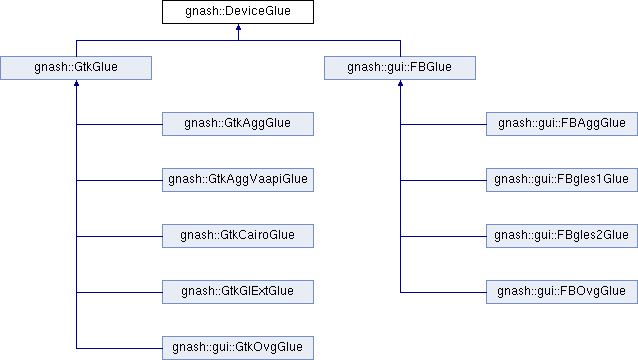#include <DeviceGlue.h>

Public Member Functions | |
| DeviceGlue () | |
| ~DeviceGlue () | |
| boost::shared_array < renderer::GnashDevice::dtype_t > | probeDevices () |
| void | resetDevice () |
| Reset the the current device, which disables output. | |
| renderer::GnashDevice::dtype_t | getDevice () |
| Get the current active device type. | |
| void | setDevice (renderer::GnashDevice::dtype_t dtype) |
| bool | initDevice (int argc, char *argv[]) |
| bool | attachWindow (renderer::GnashDevice::native_window_t window) |
| bool | bindClient (renderer::GnashDevice::rtype_t rtype) |
| size_t | getWidth () |
| size_t | getHeight () |
| size_t | getDepth () |
| Depth of the display. | |
| bool | swapBuffers () |
| Make the current buffer the active one. | |
Protected Attributes | |
| boost::scoped_ptr < renderer::GnashDevice > | _device |
Constructor & Destructor Documentation
| gnash::DeviceGlue::DeviceGlue | ( | ) | [inline] |
| gnash::DeviceGlue::~DeviceGlue | ( | ) | [inline] |
Member Function Documentation
| bool gnash::DeviceGlue::attachWindow | ( | renderer::GnashDevice::native_window_t | window | ) | [inline] |
Attach the area to draw in to the lower level device. This makes the drawing area available to the dispaly device when binding the display to the native windowing system or framebuffer.
References _device.
| bool gnash::DeviceGlue::bindClient | ( | renderer::GnashDevice::rtype_t | rtype | ) | [inline] |
Bind the client API to the device. As EGL can support different renderers, namely OpenGL, OpenGLES1, OpenGLES2, and OpenVG. This is how the underlying hardware knows which API to implement.
References _device.
| size_t gnash::DeviceGlue::getDepth | ( | ) | [inline] |
| renderer::GnashDevice::dtype_t gnash::DeviceGlue::getDevice | ( | ) | [inline] |
Get the current active device type.
References _device.
| size_t gnash::DeviceGlue::getHeight | ( | ) | [inline] |
Height of the drawing area, in pixels. For framebuffer based devices, this is the size of the display screen.
Reimplemented in gnash::gui::FBAggGlue.
References _device.
Referenced by gnash::gui::FBGui::init().
| size_t gnash::DeviceGlue::getWidth | ( | ) | [inline] |
Get the Width of the drawing area, in pixels. For framebuffer based devices, this is the size of the display screen.
Reimplemented in gnash::gui::FBAggGlue.
References _device.
Referenced by gnash::gui::FBGui::init().
| bool gnash::DeviceGlue::initDevice | ( | int | argc, |
| char * | argv[] | ||
| ) | [inline] |
Initialze the device
- Parameters:
-
argc The count of arguments from the command line argv The array of command line arguments
- Returns:
- status
References _device.
| boost::shared_array<renderer::GnashDevice::dtype_t> gnash::DeviceGlue::probeDevices | ( | ) | [inline] |
Probe the system to see what types of display devices exist. This doesn't select a device, it merely returns a list of what is available.
- Returns:
- a list of devices
References GNASH_REPORT_FUNCTION.
Referenced by gnash::gui::GtkOvgGlue::init().
| void gnash::DeviceGlue::resetDevice | ( | ) | [inline] |
Reset the the current device, which disables output.
References _device.
| void gnash::DeviceGlue::setDevice | ( | renderer::GnashDevice::dtype_t | dtype | ) |
Set the display device for later use. After this is called, the display device is active
References _device.
Referenced by gnash::gui::GtkOvgGlue::init().
| bool gnash::DeviceGlue::swapBuffers | ( | ) | [inline] |
Make the current buffer the active one.
References _device.
Member Data Documentation
boost::scoped_ptr<renderer::GnashDevice> gnash::DeviceGlue::_device [protected] |
Referenced by setDevice(), resetDevice(), getDevice(), initDevice(), attachWindow(), bindClient(), getWidth(), getHeight(), getDepth(), swapBuffers(), gnash::gui::FBAggGlue::init(), gnash::gui::FBAggGlue::createRenderHandler(), gnash::gui::FBAggGlue::render(), gnash::gui::FBAggGlue::width(), gnash::gui::FBAggGlue::height(), gnash::gui::FBAggGlue::getWidth(), gnash::gui::FBAggGlue::getHeight(), gnash::gui::FBAggGlue::getDepth(), gnash::gui::FBOvgGlue::render(), gnash::gui::GtkOvgGlue::init(), gnash::gui::GtkOvgGlue::prepDrawingArea(), and gnash::gui::GtkOvgGlue::setRenderHandlerSize().
The documentation for this class was generated from the following files:
 1.7.5
1.7.5